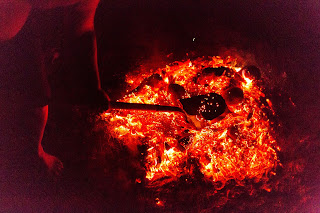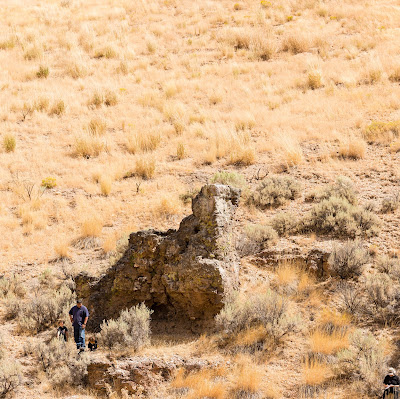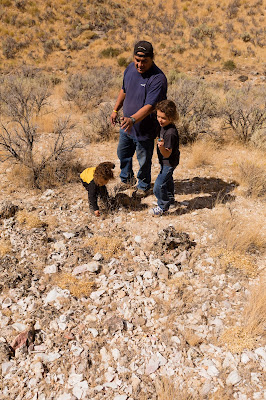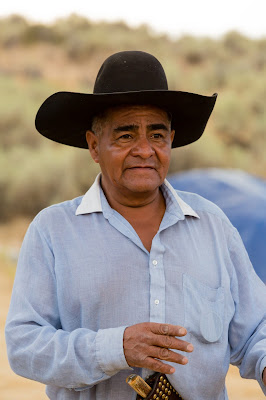Sacred Site Under Siege
This article appeared on Indian County Today Media Network in 2016. For more on topics like this, see my book, American Apartheid: The Native American Struggle....

A fire glows outside a sweat lodge, where Western Shoshones are gathered with a healer to pray and sing in the language of their ancestors. Sparks fly up toward the Milky Way streaming overhead in the night sky. In the surrounding expanse of sand and sagebrush, a faint trail is etched into the land. Centuries ago, an ancestral healer moved across these hills, singing and gathering medicinal herbs.
 Ongoing usage by Western Shoshones leaves
a cultural tracery on the land showing that Tosawihi is a busy place—of prayer,
healing and a history that stretches back to the beginning of time. Sometimes
called Tosawihi “Quarries,” that name is falling out of favor among tribal
members because it fails to express the intricate cultural and spiritual bonds
among the landscape and its people.
Ongoing usage by Western Shoshones leaves
a cultural tracery on the land showing that Tosawihi is a busy place—of prayer,
healing and a history that stretches back to the beginning of time. Sometimes
called Tosawihi “Quarries,” that name is falling out of favor among tribal
members because it fails to express the intricate cultural and spiritual bonds
among the landscape and its people.
 “Look, just like mine!” Julius Jr. exclaimed.
He held up a small partially finished white-flint arrowhead that was shaped like
the black obsidian one he’d worked on with his grandfather the day before; he
then put it back where one of his ancestors had placed it ages ago—a profound
and effortless connection across time.
“Look, just like mine!” Julius Jr. exclaimed.
He held up a small partially finished white-flint arrowhead that was shaped like
the black obsidian one he’d worked on with his grandfather the day before; he
then put it back where one of his ancestors had placed it ages ago—a profound
and effortless connection across time.
 We drove to a cliff that overlooked an
expanse—a small portion of the entire Complex—that the BLM has dubbed an
Archaeological District for its concentration of flakes and points. Not relevant,
said Holley, who believes the entire area should be understood as a Traditional
Cultural Landscape. The term signifies a place subtly shaped by not only hunting, but also gathering, food preparation, medicine-plant
cultivation, ceremonies and more. Though preservationists fully recognize the
concept, it can be harder for some to comprehend than, for example, an historic
house.
We drove to a cliff that overlooked an
expanse—a small portion of the entire Complex—that the BLM has dubbed an
Archaeological District for its concentration of flakes and points. Not relevant,
said Holley, who believes the entire area should be understood as a Traditional
Cultural Landscape. The term signifies a place subtly shaped by not only hunting, but also gathering, food preparation, medicine-plant
cultivation, ceremonies and more. Though preservationists fully recognize the
concept, it can be harder for some to comprehend than, for example, an historic
house.
 “Interesting you should ask,” said Sope (shown right), responding to a question about when his people got the horse. Their first mount
was not the Spanish mustang that other tribes acquired, but rather Eohippus, a multi-toed horse that lived
55 to 35 million years ago, he said. “First they were little, and we hunted and
ate them. As they evolved into animals the size of a dog, we used them to pull
travois [joined poles forming a sled].”
“Interesting you should ask,” said Sope (shown right), responding to a question about when his people got the horse. Their first mount
was not the Spanish mustang that other tribes acquired, but rather Eohippus, a multi-toed horse that lived
55 to 35 million years ago, he said. “First they were little, and we hunted and
ate them. As they evolved into animals the size of a dog, we used them to pull
travois [joined poles forming a sled].”

A fire glows outside a sweat lodge, where Western Shoshones are gathered with a healer to pray and sing in the language of their ancestors. Sparks fly up toward the Milky Way streaming overhead in the night sky. In the surrounding expanse of sand and sagebrush, a faint trail is etched into the land. Centuries ago, an ancestral healer moved across these hills, singing and gathering medicinal herbs.
Now known as the Tosawihi Complex, the
area encompasses scores of square miles in Nevada’s Great Basin. Western
Shoshones call it the spiritual heart of their traditional homeland, which
includes most of Nevada and portions of Idaho, Oregon, California and Utah. Tosawihi
(pronounced DOS-a-wee) is named for a band whose name translates as White
Knives. The group was famed, and feared, for carrying razor-sharp blades made
from the white flint found here.
 Ongoing usage by Western Shoshones leaves
a cultural tracery on the land showing that Tosawihi is a busy place—of prayer,
healing and a history that stretches back to the beginning of time. Sometimes
called Tosawihi “Quarries,” that name is falling out of favor among tribal
members because it fails to express the intricate cultural and spiritual bonds
among the landscape and its people.
Ongoing usage by Western Shoshones leaves
a cultural tracery on the land showing that Tosawihi is a busy place—of prayer,
healing and a history that stretches back to the beginning of time. Sometimes
called Tosawihi “Quarries,” that name is falling out of favor among tribal
members because it fails to express the intricate cultural and spiritual bonds
among the landscape and its people.
The place is ancient, but the fight to
protect it is contemporary. Decades of mining have left scars. Like 83 percent
of Nevada, Tosawihi sits on federal land administered by the Bureau of Land Management
(BLM), an Interior Department agency. The BLM, which issues mining permits, calls
Western Shoshone accusations of mining-related destruction the product of a
“different worldview.” Tribal members say that if the BLM followed federal law,
including historic-preservation and environmental regulations, damage could be
avoided.
In June, a three-judge panel of the Ninth
Circuit Court of Appeals refused to stay construction for a mining-related
power line in Tosawihi (shown here) until a way could be found to save the ancestral
healer’s trail, which had been determined eligible for the National Register of
Historic Places. The Band appealed the ruling. Despite the issue still being
before the courts, employees of Carlin Resources, part of an international
consortium that owned an open-pit gold mine in Tosawihi, fired up their yellow
bulldozer. They plowed a rough, nearly 12-mile-long road, along with
50-foot-wide gashes for the bases of the utility poles. They gouged a trench
into the side of a nearby hill used for vision quests.
They obliterated much of the healer’s
trail, along with the natural pharmacy he cultivated alongside it. Tanya
Reynolds, an official of the South Fork Band of the Te-Moak Western Shoshone,
called the destruction “beyond words, beyond what is possible to fix.”
“They’re after money and will literally
move mountains to get it,” said Murray Sope, from Duckwater Shoshone Tribe.
“But these places are also very valuable to us for teaching our children.”
Demolition of irreplaceable ancient
artifacts usually merits outrage, or at least notice. The Islamic State, or
ISIS, was widely condemned when it released footage of a yellow bulldozer
demolishing the Gates of Ninevah, in the remains of an ancient city in Iraq. Major
media outlets reported shock worldwide when ISIS smashed museum exhibits and
when the Taliban blew up the Buddhas of Bamiyan, in Afghanistan.
In contrast, portions of Tosawihi have simply
vanished in a national, and international, blind spot (see the gold mine in Tosawihi, left). “We don’t understand
their need to destroy,” said Joe Holley, former chairman and now councilman of
the Battle Mountain Band of the Te-Moak Western Shoshone. “We are realistic. We
know we can’t stop them entirely, but we want them to partner with us. They
need to listen when we flag endangered cultural resources. They need to follow
their own laws.”
Federal authorities have permitted
destruction of Native sites nationwide. In September, more than 1,200 museum
directors and scholars condemned the builders of the Dakota Access Pipeline (DAPL)
for destroying Sioux burial grounds in North Dakota with apparent U.S. Army
Corps of Engineers authorization. The Obama administration asked the builders,
Energy Transfer Partners, to halt work until it could scrutinize tribal-consultation
policies, including how they had been applied in the DAPL process.
That did not necessarily signal a policy
change, though. A few weeks later, under a permit issued on behalf of President Obama by the Federal Energy Regulatory Commission, the same
company bulldozed ancient Native sites in Texas, turning them into a sea of mud.
In Tosawihi, the BLM-authorized power line
stoked fears of more aggressive mining to come, said Reggie Sope, the healer from
Duckwater Shoshone Tribe who ran the sweat lodge ceremony.
“Work began yesterday,” confirmed John Seaberg,
senior vice president of the gold mine’s new owner, Klondex, which bought the
operation on October 4. Depending on the results of exploratory testing, the
company may install another ramp (inclined mining tunnel), Seaberg said. He
called tribes “key stakeholders” in the process but refused to comment on ongoing
lawsuits. They include Carlin’s suit against the Battle Mountain Band, which
the Band has asked the courts to dismiss.
Sunrise
in Tosawihi
The next morning in camp in Tosawihi, we
had a hearty breakfast grilled in an oversize cast-iron skillet set over an
open fire. Afterward, Holley told us more about the ancestral healer and showed
us where he practiced. As the medicine man passed by, picking plants and
digging roots, people heard his song. Those who needed treatment followed him
to a grassy meadow or to a small pool created by setting rocks in a stream, where
he would bathe them.
Near the treatment areas, Holley pointed
out small dome-like shelters (shown here) formed by hollowing out arched rock outcroppings. One
shelter faced a terrace and had a cavity carved into the back wall. Holley’s little
grandsons, Julius Jr. and Wanbli, played around it, as their granddad explained
how tribes have used the area. Nowadays, vehicles can bump into Tosawihi via
rough mining roads, but in the past, people entered on foot or on horseback via
mountain passes. They sought the local white flint, used in healing as well as tool-making.
 “Look, just like mine!” Julius Jr. exclaimed.
He held up a small partially finished white-flint arrowhead that was shaped like
the black obsidian one he’d worked on with his grandfather the day before; he
then put it back where one of his ancestors had placed it ages ago—a profound
and effortless connection across time.
“Look, just like mine!” Julius Jr. exclaimed.
He held up a small partially finished white-flint arrowhead that was shaped like
the black obsidian one he’d worked on with his grandfather the day before; he
then put it back where one of his ancestors had placed it ages ago—a profound
and effortless connection across time.
According to Sope, traditional lifeways
were meticulously sustainable. Old winter camps sit by tree-sheltered warm
springs and near rock walls that radiate the sun’s heat. “We cultivated the
riches of the land by taking a little here and a little there—hunting and
gathering roots, seeds and medicinal plants.” Sope gestured toward nearby
sagebrush bushes. “A home or sweat lodge could be made with a few hides thrown
over them. Nothing was overused, nothing went to waste.”
Though archaeological studies focus on hunting
and hunting implements, items found around the Complex are also domestic—grinding
stones for the nuts and seeds that dominated the people’s diet, bowls, axes, awls,
sharpeners, hide scrapers, ornaments and sewing tools. In a separate interview,
Leah Brady, a basketmaker, an educator and—along with the Holleys, the Sopes
and their kin—a White Knives Band member, said she’d like to see a thread gauge,
with graded holes for measuring the diameter of basket-making material made
from willow bark and other plants.
 We drove to a cliff that overlooked an
expanse—a small portion of the entire Complex—that the BLM has dubbed an
Archaeological District for its concentration of flakes and points. Not relevant,
said Holley, who believes the entire area should be understood as a Traditional
Cultural Landscape. The term signifies a place subtly shaped by not only hunting, but also gathering, food preparation, medicine-plant
cultivation, ceremonies and more. Though preservationists fully recognize the
concept, it can be harder for some to comprehend than, for example, an historic
house.
We drove to a cliff that overlooked an
expanse—a small portion of the entire Complex—that the BLM has dubbed an
Archaeological District for its concentration of flakes and points. Not relevant,
said Holley, who believes the entire area should be understood as a Traditional
Cultural Landscape. The term signifies a place subtly shaped by not only hunting, but also gathering, food preparation, medicine-plant
cultivation, ceremonies and more. Though preservationists fully recognize the
concept, it can be harder for some to comprehend than, for example, an historic
house.
Some Tosawihi sites are impossible for
outsiders to apprehend—places where songs and visions were acquired, or where children
were conceived or birthed. “Those places are sacred, too,” said Reynolds.
Later, Holley commented on the Native
concept of the sacred. “For us, if something is sacred, nothing and no one can
change that,” he said. In contrast, for non-Natives, sacredness can be gained
by consecration—when a religious authority makes an item or place sacred—and
lost via its opposite, deconsecration. Christian churches and Jewish synagogues
have been stripped of sacred status so they could be demolished or repurposed
as homes, theaters and nightclubs, while graveyards have been deconsecrated and
the bones moved. Holley found that shocking.
A
time before time
Archaeologists have found evidence dating
the beginning of the Tosawihi occupation to something like 14,000 years ago, or
nearly 11,000 years before the founding of Rome. Reggie Sope sees far earlier
connections.
 “Interesting you should ask,” said Sope (shown right), responding to a question about when his people got the horse. Their first mount
was not the Spanish mustang that other tribes acquired, but rather Eohippus, a multi-toed horse that lived
55 to 35 million years ago, he said. “First they were little, and we hunted and
ate them. As they evolved into animals the size of a dog, we used them to pull
travois [joined poles forming a sled].”
“Interesting you should ask,” said Sope (shown right), responding to a question about when his people got the horse. Their first mount
was not the Spanish mustang that other tribes acquired, but rather Eohippus, a multi-toed horse that lived
55 to 35 million years ago, he said. “First they were little, and we hunted and
ate them. As they evolved into animals the size of a dog, we used them to pull
travois [joined poles forming a sled].”
Later, they were big enough to ride. “And
we were lords of the Plains,” said Sope, miming the gesture of drawing a bow.
Before that, according to Brady, when
time began, her people arrived in the area in a lidded basket. A chief in what
is now California had given it to Coyote as part of an enticement to get the
troublemaker to leave. The vessel came with orders not to open the top. Feeling
the basket move and hearing singing inside, Coyote eventually couldn’t resist
taking a peek. The ancestors of today’s Western Shoshones ran out and populated
what came to be their homeland.
“This place survived all that time, but
not the 1872 mining law,” Holley said.
Congress passed the General Mining Law of
1872 to lure settlers west. The act offered mining patents for a few dollars
per acre, with no royalties due (unlike other extractive industries) and no cleanup
required. According to the BLM, the law “declared all valuable mineral deposits in land
belonging to the United States to be free and open to exploration and
purchase.” The policy is still
in force, pouring billions of dollars’ worth of public resources into private
hands.
With no
environmental controls, miners
walked away when claims were worked out, abandoning hundreds of thousands of
mines. The BLM reports that unwary tourists have died after falling into mine
shafts or breathing toxic gases; meanwhile, explosives left behind hinder
rescuers. Modern mines also offer hazards. Grates over pits associated with the
Tosawihi gold mine have gaps a child or small animal could fall through.
The devastation is immense and ongoing,
said Reggie Sope. The Environmental Protection
Agency’s 2011 Toxics Release Inventory shows that mining accounted for 98
percent of the 529 million pounds of toxins released in Nevada that year,
according to Progressive Leadership Alliance of Nevada (PLAN).
Long after the digging stops, cyanide,
arsenic and other mining-related poisons wash into rivers and evaporate into
the atmosphere, with taxpayers picking up the tab. Earthworks,
a mining-focused environmental group, estimates that the public will pay as
much as $72 billion to clean up old mines. Cleaning up today’s operations will cost
additional billions.
Meanwhile, Western Shoshones strive to
protect the Tosawihi Complex. Joe’s mother,
Kathleen Holley, is 83. She has been coming here all her life. “It’s
worse than ever,” she said, looking out over the rolling hills. “I see
disrespect everywhere. So many of the animals are gone. What will be left for
the children?”
Text c. Stephanie Woodard; photographs c. Joseph Zummo.





